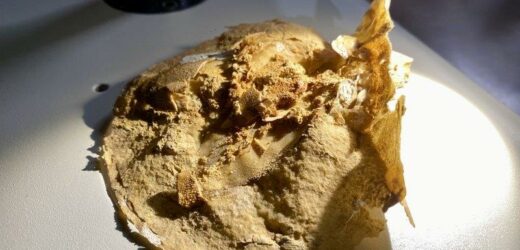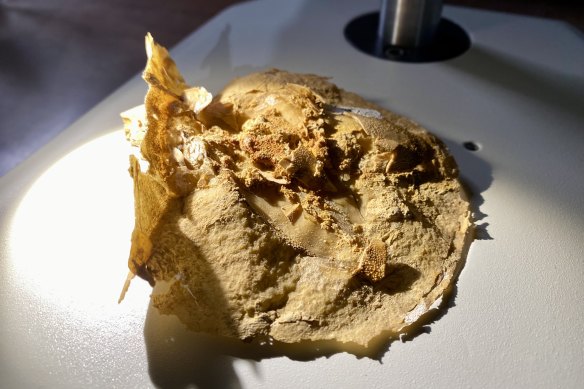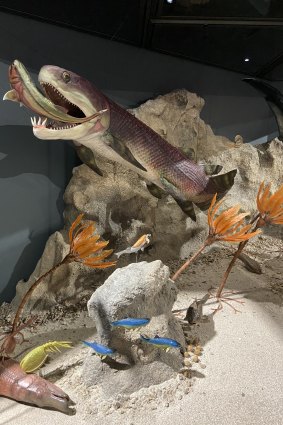The oldest heart ever found has been uncovered in a three-dimensional fossil of a 380-million-year-old fish found in Western Australia’s north.
Curtin University-led research studying the fossil of the ancient jawed fish collected from the Gogo Formation (once a large reef) in the Kimberley region was published in the journal Science on Friday, and scientists believe the discovery could shed a new light on human evolution.
The preserved stomach of a Gogo fish fossil under the microscope. Credit:Curtin University
It is the first time scientists have been able to look at a three-dimensional model of a “complex S-shaped heart” in an arthrodire — an extinct class of armoured fish. Alongside the heart was a separate fossilised stomach, intestine and liver.
Enlisting the help of scientists at the Australian Nuclear Science and Technology Organisation in Sydney and the European Synchrotron Radiation Facility in France, researchers used neutron beams and synchrotron X-rays to scan the specimens, still embedded in limestone.
They then reconstructed the images of the soft tissues inside them based on the different densities of minerals deposited by the bacteria and the surrounding rock.
Lead research, Curtin University School of Molecular and Life Sciences Distinguished Professor Kate Trinajstic, said the discovery was remarkable given soft tissues of ancient species were rarely preserved.
“As a palaeontologist who has studied fossils for more than 20 years, I was truly amazed to find a 3D and beautifully preserved heart in a 380 million-year-old ancestor,” Trinajstic said.
“Evolution is often thought of as a series of small steps, but these ancient fossils suggest there was a
larger leap between jawless and jawed vertebrates.
“These fish literally have their hearts in their mouths and under their gills – just like sharks today.”
A Gogo fish diorama at the WA Museum Boola Bardip.Credit:Curtin University
Trinajstic said these features were advanced for such early vertebrates, and the discovery had provided evidence on how the head and neck region began to change to accommodate jaws – a critical stage in human evolution.
“For the first time, we can see all the organs together in a primitive jawed fish, and we were especially surprised to learn that they were not so different from us,” she said.
Research co-author Professor John Long, from Flinders University, described the discovery of soft tissue fossils as “the stuff of palaeontologists’ dreams”.
“Without doubt these fossils are the best preserved in the world for this age. They show the value of the Gogo fossils for understanding the big steps in our distant evolution,” he said.
“It is now one of the most significant fossil sites in the world. It’s time the site was seriously considered for world heritage status.”
Co-author Professor Per Ahlberg, from Uppsala University in Sweden, said most cases of soft-tissue preservation were found in flattened fossils, where the soft anatomy was “little more than a stain on the rock”.
“We are also very fortunate in that modern scanning techniques allow us to study these fragile soft tissues without destroying them. A couple of decades ago, the project would have been impossible,” he said.
Follow WAtoday on Instagram, LinkedIn, Facebook and Twitter for handpicked selections of the day’s biggest local, national and international news.
Most Viewed in National
From our partners
Source: Read Full Article




